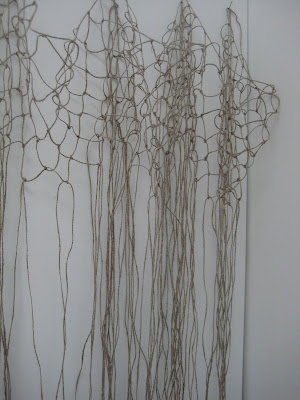Below are a few images which demonstrate the diversity of her work. Some vivid colours, some neutral, some extraordinarily complex structures created through computer programming and other simple knotting and tying techniques. Her inspiration comes from a spectrum of sources, such as water, space, flora and even scientific DNA structures. I'm certain that the extent of her experimentation will amuse and amaze any onlooker!






















I have been aware of Nora Fok for a while as the constructive nature of her work particularly appeals to me as does her extensive study of self-taught hand techniques such as knitting, knotting, tying, weaving, plaiting. Her craft is truly pioneering with her creation of delicate, intricate forms from nylon monofilament. It was fascinating to learn of the path and creative development which led her to this point, from her initial tedious factory work which gave her an initial insight into construction to her incredibly complex collaborative computer aided design work with her son. She describes her 'eureka' moment as the day, after much experimentation that she finally perfected the right temperature to boil her nylon structures around golf balls so that they would hold their form.





Her innovative discovery of knitting around golf balls and heating her nylon to hold a definite form has lead her to investigate using other objects. I particularly like her use of beautifully shaped stones.
Despite the majority of her work having being made from man-made plastics, she has manipulated her chosen media in a way which gives it a very organic and convincingly natural appearance (see pieces below). The ability to dye monofilament has made me wonder whether it would be a good choice for weaving in the weft as it could give my fabric a stronger form and structural quality.


The exhibition also featured a collection of Fok's hand crafted insects made from found leaves, twigs and seeds. The natural untouched quality of this medium is in total contrast to her other highly manipulated nylon structures which dominate the exhibition. Nevertheless they have been created with great detail and show the versatility of the artist.





























